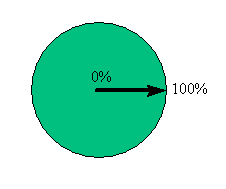There are two different kinds of gradients in Lens Effects, Radial and Circular. Between the two types, you can achieve almost limitless effects.
Radial gradients work from the center point to the outer edge of a Lens Effects feature, changing color or brightness in a straight line from left to right as you scan the gradient bar. The left edge of the gradient is aligned with the center of the effect and the right edge is aligned with the outer edge of the effect.

Scheme of a radial gradient
Changes colors in a circular manner, working clockwise around a Lens Effects feature. If you mark North, East, South, and West on a circle, these points represent the 0%, 25%, 50%, and 75% marks of the gradient.
Each parameter panel in Flare, Glow, and Highlight that utilizes gradients contain five gradient controls. The five controls are:

Scheme of a circular gradient
Defines the colors used for an effect. This is based on the RGB color system, but can also be set with HSV. Within each set of gradient controls, there is a Radial and Circular Color gradient. Radial Color works with Circular Color to produce the overall color for the Lens Effects element.
Varies the visibility of parts of the effect. The transparency gradients only make use of brightness (or luminance) values, which are essentially grayscale values. This black-to-white ramp of values provides you with 256 levels of transparency for your effects. Just like the Color gradients, both Transparency gradients are tied together to generate the overall visibility of effect. See Gradient Options.
Varies the size of specific parts of the Lens Effect. Most size gradients are used to affect the radius of a lens flare part, such as a glow. Like transparency gradients, only the brightness values are used to provide you with 256 different sizes.
The Radial Size gradient, for example, works both like a Radial and Circular gradient. This gradient is applied in a clockwise fashion, starting at 12 o'clock. The values in the gradient are applied from the center of the effect toward the outer edge, with brighter values producing bigger sizes and darker values producing shorter sizes.